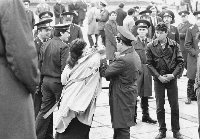Ethnic Policy is a Delicate Matter

Mykola Rutko, Head of the State Committee on Issues of Nationality and Migration, answers the questions of Vitaly Kuksa, The Day's correspondent:
It is generally known that Ukraine is a multinational country. For instance, representatives of 69 so-called "ethnic minorities" live in Chernivtsi Oblast alone. By the way, there is nothing insulting about the term "ethnic minority." It is a widespread term bearing a quantitative characteristic about a group of people first and foremost. It means that representatives of a nationality are less than those of the titular nation, i.e., the nation after which a country is named. Such notions as "nation", "people", and "nationality" were to some extent artificially introduced in our life during the Soviet era, giving more numerous nationalities more privileges. According to the law, an "ethnic minority" is a group of people who are aware of their national identity and have common social and cultural interests.
Q.: What political trends are characteristic of national groups in Ukraine?
A.: One has to agree with the fact that 14 million Ukrainian citizens are a significant political force. And it, of course, will be involved in elections. It is expected that a considerable part of the Russians will vote for a presidential candidate who promises to strengthen the integration processes with Russia. The country's leadership has bo be aware of the fact that we will have a powerful destabilizing factor in case we fail to reconcile the ethnic minorities and win them over to the side of the Ukrainian political nation, i.e., to ourpublic, historical, and social communities.
Q.: Is the problem of interethnic conflicts pressing for Ukraine?
A.: There is no other more delicate sphere than that of interethnic relations. Many politicos, journalists, and other state and public figures consider themselves specialists in this area and often make thoughtless statements. Due to this the interethnic and internal ethnic situation looks like a snow ball. It sometimes happens in the Crimea where the Russian "minority" is in fact a majority. We can also recall the recent incident of shutting down Romanian schools in Odesa oblast. Sometimes the situation within some ethnic groups happens to be quite tense, too. There are some communities of the same nationality who are in conflict among themselves. Sometimes those conflicts are just a reaction to some events in their historical homeland. Such a situation can also lead to escalating interethnic tension. Thus, the prevention of interethnic and internal ethnic conflicts is also among the main tasks of the committee.
Incidentally, we use in our work the statistical data of 1989 population census. Thus, we do not know the exact number of representatives of some ethnic minorities. To some extent we can correct those figures analyzing the migration processes as those of returning deported peoples. We are looking forward to a results of a new census which is scheduled to be conducted in three years.
The Day's Information
According to an Ethnic Directory published two years ago by the Committee on Ethnic Minorities jointly with the Institute of Ethnic, Regional, and Diaspora Studies and the Center for Ethno-sociology and Ethno-political Studies of the Institute of Sociology, there were 128 nationalities inhabiting Ukraine in 1989.
Apart from the titlular nation - Ukrainians - who made up then 37.419,000; 11.4 million Russians, and 440,000 Belarusians, the most numerous minorities were Moldovans (342,500), and Bulgarians (234,400). Also significant are the Jewish minority (486,000), Poles (219,000), Romanians (134,000), Greeks (98,600), and Hungarians (163,000). The number of Crimean Tartars then was 47,000 while now it has increased to about 250,000. Quite significant is also the other Tartar minority - 86,900. The number of Germans has grown almost twice in the past nine years - 75,000 instead of 37,800.
Cultural interests of the smallest national minorities, first of all those of the North and Siberia, need no less attention. In 1989, 10 Nivkhs, 10 Negidals, 9 Izhors, 8 Kets whose language belongs to no one language family, 3 Toftallars, 3 Yukagirs, 3 Eskimoes, 2 Itelmens, 2 Oroks (not to be mixed up with Oroches - there are 19 of them in Ukraine), 1 Enet, and 1 Nagasan enjoyed full rights of Ukrainian citizenship.
Some titlular nation representatives of the so-called "developed" countries also consider Ukraine their homeland. Apart from the mentioned Germans, there are 1086 Finns, 729 Spaniards (plus 520 Cubans), 679 Chinese, 316 Italians, 175 representatives of the peoples of India, 168 Frenchmen, 80 Swedes, 64 Austrians, 58 Englishmen, 44 Dutch, 23 Japanese, and 11 Americans.
The variety of "Ukrainian International" will not be complete if we do not mention 54,200 Armenians, 47,900 Gypsies, 36,900 Azerbaijanians, 23,500 Georgians, 20,400 Chuvashs, 20,330 Uzbeks, 19,33 Mordvins, 11,300 Lithuanians, 10,500 Kazakhs, 9,100 Czechs, 8,600 Udmurts, and 7,900 Slovaks.
How different now is the "Ethnic picture" of the Ukrainian land we will see after 2001. We do not wish it less colorful. The return of deported peoples and returning to their historical homeland are still the main trends in these changes.
Выпуск газеты №:
№36, (1998)Section
Day After Day





